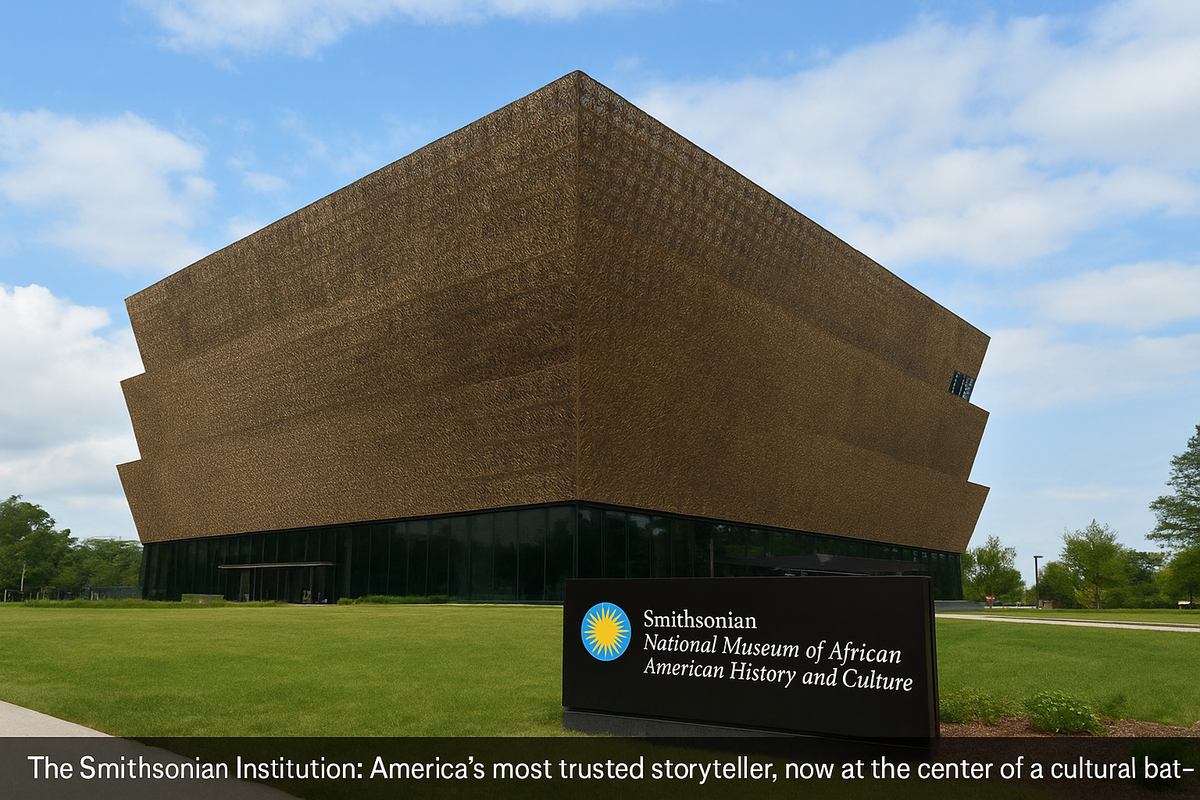Trump vs the Smithsonian: A Culture Clash Over History
The Smithsonian controversy highlights America’s ongoing culture clash: Is history about pride or truth? Trump’s call for a federal review fuels debate over patriotism, memory, and how the nation defines itself.

History is never just about the past. It’s about how we understand who we are in the present and who we hope to become in the future. Few institutions embody this truth more than the Smithsonian Institution, often called “the nation’s attic,” where artifacts, documents, and exhibitions weave together the complex tapestry of American identity. Yet, in 2025, this storied institution finds itself at the center of a cultural firestorm, sparked by none other than President Donald Trump.
In a recent address, Trump accused the Smithsonian of focusing “too much” on slavery in its exhibits, charging that the museum complex presents a narrative of America defined by oppression and division rather than achievement and greatness. He has floated the idea of a federal review of the Smithsonian’s programs, suggesting that a taxpayer-funded institution must represent what he calls a “balanced” view of history.
The statement has ignited fierce debate between historians and politicians, educators and activists, conservatives and progressives over not only the Smithsonian’s mission but also the role of public memory in shaping national identity.
The Smithsonian’s Role in Telling America’s Story
The Smithsonian is more than just a museum complex; it’s a cultural cornerstone. With 21 museums, the National Zoo, and extensive research centers, it tells stories that span from dinosaurs to spacecraft, from jazz to indigenous artifacts.
In recent decades, however, a notable shift has occurred: a growing emphasis on amplifying marginalized voices. Exhibitions such as the National Museum of African American History and Culture, the National Museum of the American Indian, and the Latino Center have sought to highlight the struggles and contributions of groups often underrepresented in mainstream historical narratives.

The Smithsonian has not shied away from confronting the darker chapters of American history: slavery, Jim Crow, Native American displacement, Japanese internment, and systemic inequality. For many scholars and citizens, this shift represents an overdue reckoning with truths long ignored.
But for critics like Trump, it represents something else entirely: a perceived overemphasis on national shame at the expense of national pride.
Trump’s Critique: A Narrative of Patriotism
President Trump has long framed his political identity around patriotic storytelling a vision of America as exceptional, strong, and blessed. His criticism of the Smithsonian aligns with this worldview. In his remarks, Trump argued that while slavery was a tragic part of history, the nation should be defined by its “heroes and victories, not by its mistakes.”
According to him, Smithsonian exhibits risk alienating younger generations by presenting an overly negative account of the nation’s past. He has positioned his critique as a defense of American pride and unity, claiming that taxpayers should not be asked to fund what he characterizes as “one-sided” interpretations of history.
By calling for a federal review, Trump is tapping into a broader conservative movement that has increasingly pushed back against what it views as “woke history” the teaching or commemoration of racial injustice, systemic inequality, and colonialism.

Why Slavery is Central to the American Story
To many historians, Trump’s critique fundamentally misses the point. Slavery is not a side note in American history; it is woven into the very fabric of the nation. From the colonial economy built on enslaved labor, to the drafting of a Constitution that wrestled with the contradiction of liberty in a slaveholding society, to the bloody Civil War and the century-long fight for civil rights slavery’s legacy is inescapable.
Ignoring or downplaying this history risks creating a false narrative of the past. Museums like the Smithsonian aim not only to celebrate achievements but also to provide context: how inventions, art, and democracy itself developed alongside systems of oppression. To gloss over slavery would not be a restoration of balance; it would be a distortion of reality.
The Smithsonian’s mission, in this sense, is not to shame America but to tell the truth to present history in all its complexity so that future generations can learn, question, and grow.
The Culture Wars Context
Trump’s remarks did not arise in a vacuum. They are part of a broader culture war in the United States over education, memory, and national identity.

- In recent years, state legislatures have passed laws limiting how schools can teach about race and slavery, targeting projects like the 1619 Project.
- Monuments to Confederate leaders have been torn down in some states while defended or even restored in others.
- Books dealing with themes of race, gender, and sexuality have been banned or challenged in libraries across the country.
In this context, the Smithsonian controversy is not just about museum displays. It is about who gets to tell the American story and which version of that story becomes “official.”
Supporters of Trump’s Position
For Trump’s supporters, the Smithsonian debate reflects a deeper frustration: the feeling that American history is being rewritten to portray the nation primarily as a villain rather than a beacon of freedom. Many believe that focusing on slavery, racism, or inequality undermines patriotism and fosters division.
This perspective argues that history should inspire pride and loyalty, particularly among young Americans. Supporters point to military victories, technological innovations, and the resilience of immigrants as examples of positive narratives that, in their view, deserve more prominence in Smithsonian exhibits.
Some also frame this as a taxpayer issue, arguing that since the Smithsonian is publicly funded, its programming should reflect “mainstream” American values rather than what they see as progressive or activist perspectives.
Opposition: Defending Historical Honesty
On the other side, critics of Trump’s remarks argue that truth is not unpatriotic. Facing the realities of slavery and systemic racism does not diminish American greatness; rather, it provides a fuller understanding of how resilience, reform, and progress were achieved.
Many historians warn that government intervention in museum curation sets a dangerous precedent. If federal reviews are used to pressure institutions into minimizing uncomfortable truths, then historical scholarship itself could be undermined.
For educators, activists, and descendants of enslaved people, the Smithsonian’s work is not about “dwelling on the past” but about connecting history to present struggles: mass incarceration, voting rights battles, and the persistence of inequality.
The Public Reaction
The reaction across the country has been swift and polarized:
- Conservative commentators praised Trump for standing up to what they call “revisionist history.”
- Progressive voices condemned the remarks as an attempt to whitewash the past.
- Museum professionals expressed concern about political intrusion, emphasizing the importance of curatorial independence.
- Ordinary citizens took to social media, some sharing personal stories of how Smithsonian exhibits helped them understand their family histories, while others echoed Trump’s sentiment that the displays make America look “ungrateful and ashamed.”
The controversy has turned the Smithsonian from a place of learning into a lightning rod of political debate.
The Federal Review Question
Trump’s suggestion of a federal review raises difficult constitutional and practical questions. The Smithsonian is chartered by Congress and funded in part by public money, but it has historically operated with significant independence in its curatorial decisions.
A formal federal review could open the door to political oversight of historical content a move that alarms many scholars. Would politicians be empowered to decide which exhibits are acceptable? Would inconvenient truths be excluded from public spaces?
At its heart, the debate over federal review is a debate over freedom of inquiry. Should museums be free to interpret history based on evidence and scholarship, or should they adjust to political priorities?
The Deeper Issue: What Kind of America Do We Want?
Beyond the politics and policy, the Smithsonian controversy touches on a deeper philosophical question: What does it mean to be American?
- Is America a story of triumph, ingenuity, and exceptionalism where slavery is an unfortunate but secondary chapter?
- Or is it a story of contradictions, where freedom and oppression coexisted, and progress was often born of struggle?
In reality, it is both. The danger lies in elevating one narrative at the expense of the other. A purely celebratory history risks becoming propaganda. A purely critical history risks cynicism. The challenge is to embrace complexity to acknowledge that the same nation that enshrined liberty also permitted slavery, and that progress came not from erasure but from confrontation and reform.
Looking Ahead: Smithsonian at a Crossroads
The Smithsonian now faces a delicate balancing act. It must continue to pursue scholarship and truth-telling while navigating a political environment that questions its legitimacy. Its curators and directors will likely resist direct federal interference, but they may also find themselves pressured to defend their choices in increasingly public ways.
At the same time, this controversy may ultimately highlight the Smithsonian’s importance. If museums were irrelevant, they would not provoke such strong reactions. That they do means they still hold immense power to shape national consciousness.
Conclusion: History as a Battleground
The clash between Trump and the Smithsonian is not just about museum exhibits. It is about the ongoing battle over how America sees itself. In one vision, history should be a source of pride and unity, glossing over darker chapters in favor of inspiration. In another, history must be a mirror, reflecting both achievements and injustices, so that future generations can build on truth rather than myth.
As the debate rages on, one thing is clear: history is not fixed. It is contested, debated, and reinterpreted with each generation. Whether the Smithsonian bends to political pressure or stands firm in its mission, the outcome will shape not only how Americans remember their past but also how they imagine their future.




